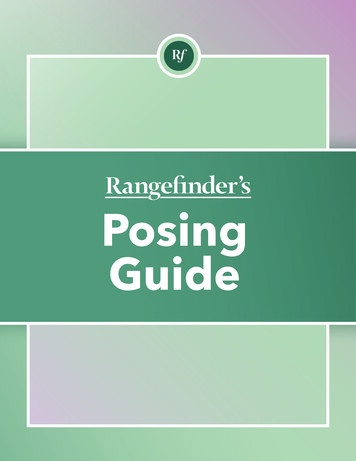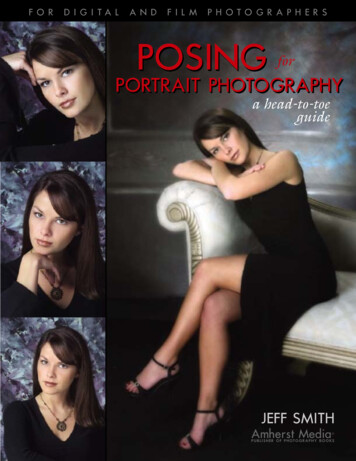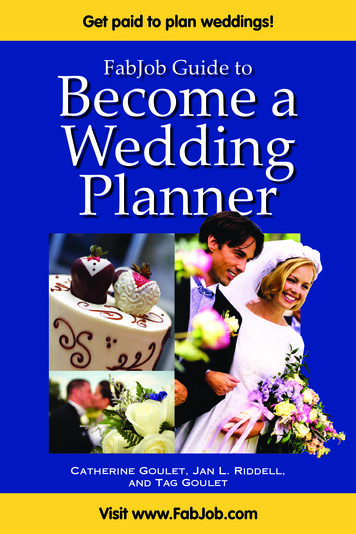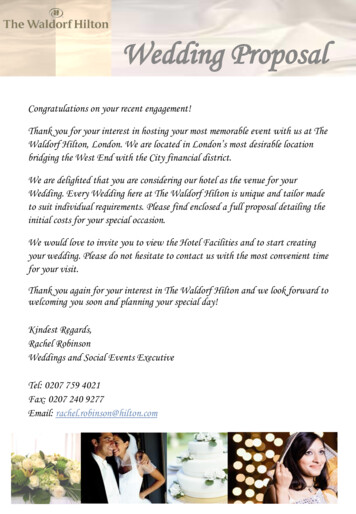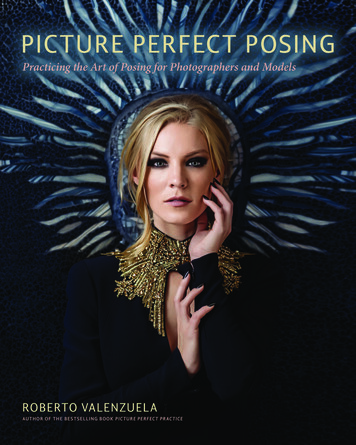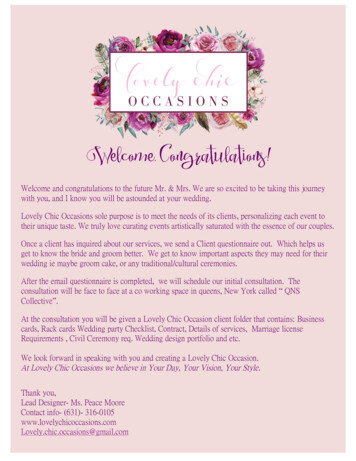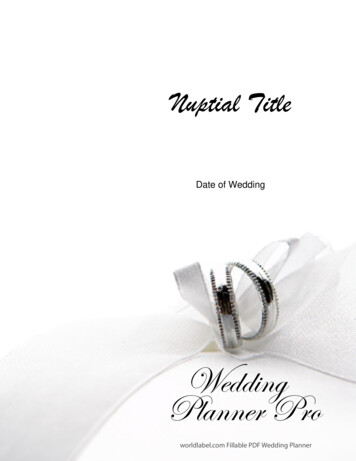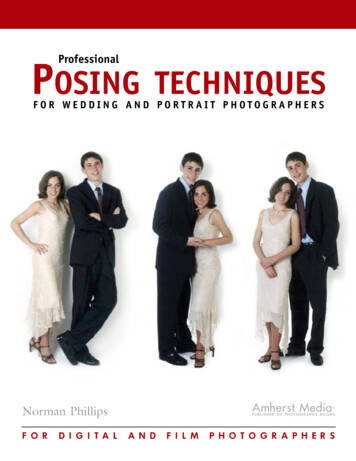
Transcription
ProfessionalPOSINGTECHNIQUESFOR WEDDING AND PORTRAIT PHOTOGRAPHERSAmherst MediaNorman PhillipsF O RD I G I T A L P U B L I S H E R O F P H OTO G R A P H Y B O O K SA N DF I L MP H O T O G R A P H E R S
Copyright 2006 by Norman Phillips.All rights reserved.Published by:Amherst Media P.O. Box 586Buffalo, N.Y. 14226Fax: 716-874-4508www.AmherstMedia.comPublisher: Craig AlesseSenior Editor/Production Manager: Michelle PerkinsAssistant Editor: Barbara A. Lynch-JohntISBN: 1-58428-170-7Library of Congress Control Number: 2005922438Printed in Korea.10 9 8 7 6 5 4 3 2 1No part of this publication may be reproduced, stored, or transmitted in any form or by any means, electronic,mechanical, photocopied, recorded or otherwise, without prior written consent from the publisher.Notice of Disclaimer: The information contained in this book is based on the author’s experience and opinions. Theauthor and publisher will not be held liable for the use or misuse of the information in this book.
ContentsINTRODUCTION . . . . . . . . . . . . . . . . . . . . . . . . . . .4What is Posing? . . . . . . . . . . . . . . . . . . . . . . . . . .4Obstacles to Good Posing . . . . . . . . . . . . . . . . .4Goals for Posing . . . . . . . . . . . . . . . . . . . . . . . . .5The Purpose of this Book . . . . . . . . . . . . . . . . . .5A Final Note . . . . . . . . . . . . . . . . . . . . . . . . . . . .57. SEATED POSES . . . . . . . . . . . . . . . . . . . . . . . .41Men . . . . . . . . . . . . . . . . . . . . . . . . . . . . . . . . . .41Women . . . . . . . . . . . . . . . . . . . . . . . . . . . . . . .438. FLOOR POSES . . . . . . . . . . . . . . . . . . . . . . . . .509. SLIMMING TECHNIQUES . . . . . . . . . . . . . . . .551. GENERAL PRINCIPLES . . . . . . . . . . . . . . . . . . .6The Formal Pose . . . . . . . . . . . . . . . . . . . . . . . . .6The Natural Pose . . . . . . . . . . . . . . . . . . . . . . . . .6The Exaggerated Pose . . . . . . . . . . . . . . . . . . . . .7Posing Basics . . . . . . . . . . . . . . . . . . . . . . . . . . . .7Posing Differences: Men vs. Women . . . . . . . . .82. BODY LANGUAGE . . . . . . . . . . . . . . . . . . . . . .10Communication . . . . . . . . . . . . . . . . . . . . . . . .10Perception . . . . . . . . . . . . . . . . . . . . . . . . . . . . .103. HEAD POSES . . . . . . . . . . . . . . . . . . . . . . . . . .1310. GROUP PORTRAITS . . . . . . . . . . . . . . . . . . . .61Groups of Two . . . . . . . . . . . . . . . . . . . . . . . . .62Groups of Three . . . . . . . . . . . . . . . . . . . . . . . .69Groups of Four . . . . . . . . . . . . . . . . . . . . . . . . .72Groups of Five . . . . . . . . . . . . . . . . . . . . . . . . . .78Larger Groups . . . . . . . . . . . . . . . . . . . . . . . . . .79Design Strategies for Group Portraits . . . . . . .8711. WEDDING PORTRAITS . . . . . . . . . . . . . . . . . .91The Bride . . . . . . . . . . . . . . . . . . . . . . . . . . . . . .91The Bride and Groom . . . . . . . . . . . . . . . . . . .102One Location, Various Options . . . . . . . . . . .1084. HANDS AND ARMS . . . . . . . . . . . . . . . . . . . . .20Breaking the Rules . . . . . . . . . . . . . . . . . . . . . .2512. GLAMOUR PORTRAITS . . . . . . . . . . . . . . . . .1115. FEET POSITIONS . . . . . . . . . . . . . . . . . . . . . . .3013. FREESTYLE POSING . . . . . . . . . . . . . . . . . .1186. STANDING POSES . . . . . . . . . . . . . . . . . . . . . .35Men . . . . . . . . . . . . . . . . . . . . . . . . . . . . . . . . . .35Women . . . . . . . . . . . . . . . . . . . . . . . . . . . . . . .38Conclusion . . . . . . . . . . . . . . . . . . . . . . . . . . .123Glossary . . . . . . . . . . . . . . . . . . . . . . . . . . . . . .125Index . . . . . . . . . . . . . . . . . . . . . . . . . . . . . . . .126CONTENTS 3
Introductionvery time I review an image, I learn something new or am remindedof something fundamental about creating photographs. You mightthink that is somewhat strange for someone who has been creatingimages for more than half a lifetime, but not one of us is so smart that wecannot learn from simply studying portraits created by our peers. Additionally, when we review our own work, we may well see that we might havebeen able to improve some of our portraits with better posing discipline.EWHAT IS POSING?The word pose as it relates to portrait and wedding photography is an allencompassing expression. Often, we discuss posing in a loose and too generalizing manner. We refer to the pose as if it were not specific, because nomatter how we freeze our subjects with our exposures, they are in a pose.The dictionary defines the word pose more specifically, as “an attitude orposition taken naturally, or assumed for effect; an artistic position or attitude.” It takes the description a step further when, in an additional definition, the term refers to the subject assuming “characteristic airs.” It is thisdefinition that applies most closely to us, the image creators.OBSTACLES TO GOOD POSINGThe majority of us are not aware of our natural and unconscious body positions, and so we do not present ourselves as well as we might. Most of ustend not to be concerned with how we place our hands, tilt our head, placeour arms, and position our feet. Women, however (at least a significantnumber), are somewhat more conscious of how they present themselvesthan are their male counterparts, especially when it comes to how theyplace their legs. Their mothers have taught most young women what is, andwhat is not, ladylike. For instance, when women are in skirts, they will sitwith their knees together. Men, on the other hand, are much more relaxedand are often careless about how they may be perceived.4NOT ONE OF US IS SO SMART THAT WECANNOT LEARN FROM SIMPLY STUDYINGPORTRAITS CREATED BY OUR PEERS.
GOALS FOR POSINGFrom the photographer’s point of view, there is more to posing than ensuring a “characteristic air” in the image. We want our subjects to be shown inthe best possible position. We want to flatter them, to make them lookgood. Yet, even in really excellent photographs, we can sometimes see flawsthat, if corrected, would make the portrait more striking. When the positions of the arms, legs, and body are not well conceived, they can be disruptive or intrusive to the composition of the image. Attention to detail is themost important of our personal disciplines, and in honing our attention todetail, we can make a real difference.EVEN IN REALLY EXCELLENT PHOTOGRAPHS,WE CAN SOMETIMES SEE FLAWS THAT,IF CORRECTED, WOULD MAKE THEPORTRAIT MORE STRIKING.THE PURPOSE OF THIS BOOKThis book will establish a code of discipline and provide sound guidelinesfor the way we present our subjects. It will serve not just as a starting pointfor those new to portrait and wedding photography but will also show mymore experienced peers how to employ some old tricks, and perhaps somenew ones too, in situations where they have at least a modicum of control.In writing this book I was inspired by my observations when reviewingother photography books and illustrated editorials, competition images,and displayed portraits. I guess that I am something of a harsh critic, notjust of other people’s posing, but also when I err in my own images. Havingsaid that, I believe that there are times when you will see merit in doingmany things totally opposite to what I am advocating. Indeed, there aretimes when I do this myself and, when doing so, I frequently like what Ihave done. So I am also going to offer a few ideas as to how to present someinteresting poses that are not exactly classic.This book is not intended to be a pretty picture book, though someimages shown may fall into that category. Instead, it is intended to be amanual of the many do’s and don’t’s concerning posing. This book willcover the fundamentals of good posing and will show how to achieve themwith the minimum of effort. Good and not-so-good examples are shownside by side so you can see the effect that making the recommended changeswill have on the portrait.A FINAL NOTEIf looking through this book helps you to avoid the posing negatives, youcan logically expect to create images that are always acceptable. On theother hand, if you learn to take advantage of some desirable posing alternatives, perhaps your images will be amongst the best there are.You will note that I do not address children’s portraiture in this book, asI believe the subject is worthy of separate discussion. Especially when working with children under the age of six, photographers may find that theirclients lack the control required to mirror the posing strategies outlined inthis book.INTRODUCTION 5
1. General Principlesf we want our subjects to look good and to present them in a flatteringway, there are four basic posing methods that we need to use: the formal, natural, and exaggerated styles, or a hybrid method that combineselements of the three former posing styles.ITHE FORMAL POSEThe formal pose is that which presents the subject in a manner that isaccepted in traditional portraiture. The female in this style is presented inan elegant, dignified pose. The male is presented in a manner that suggestshe is gentlemanly and is a suitable companion for the elegant female. Hewill appear strong and supportive.THE NATURAL POSEThis style will generally be relaxed and allow the subject to relate naturallyto the camera. When subjects are allowed to present themselves in a totallynatural way, however, they often look clumsy, awkward, or otherwise inelegant, so we will need to modify their presentation. This refinementshould be subtle and should be carried out with diplomacy.When you observe the two young ladies in examples 1 and 2, you willsee that they do not appear to be conscious of the principles of good bodypresentation. Both examples show common positions that we will seewhen the subjects are not asked to pose. The subjects look relaxed and comfortable, but they do not look as good as they should.In example 1, the first flaw is the position of their feet. The second flawis that their hands and arms are shown in a less than flattering way. Theirleg positions are far too casual and do not present the lines that make thefemale form attractive. In example 1, the young woman on the left has herhands hidden in such a way as to suggest a “photographic amputation.”The hands of the young woman on the right look slightly deformed, andher left arm simply appears too passive. Her shoulders are turned at too6WHEN SUBJECTS ARE ALLOWED TO PRESENTTHEMSELVES IN A TOTALLY NATURAL WAY,HOWEVER, THEY OFTEN LOOK CLUMSY,AWKWARD, OR OTHERWISE INELEGANT.
image 1image 2great an angle to the camera and therefore appear narrow; this makes herwaist look far wider than it really is. In fact, she might well think she looksfat. That is a bad pose.In example 2, the young lady at the right is in a common female leg position with her knees touching and her feet apart. It is an exaggerated posethat we can refine for the desired results.THE EXAGGERATED POSEIn the exaggerated pose, we deliberately create a presentation of the subjectin which they may not necessarily be comfortable, but from the cameraposition they look great, even dynamic. This style is for those who wanttheir images to create impact and to perhaps present a dramatic attitudethat transcends the personality of the subject. Some of these poses will bedesigned to portray aggression, belligerence or protest, or sheer exuberance.Such poses may also indicate depression or sadness, excitement or happiness, or even euphoria. Except for those trained to be very prim and properand express themselves with pure language, humans generally use body language to enhance their verbal skills, and our images can do the same withexpressive and creative poses. Of course, we need to make sure that whenwe use exaggerated poses they also present our subjects in the best possiblestyle.POSING BASICSIn other than simple head-and-shoulders poses, we should seek to createlines in our portraits that are attractive and make good composition. Thisrequires us to have diagonal, curving, and circular lines in our composition,not boring vertical and horizontal lines. When posing women for a fullGENERAL PRINCIPLES 7
length portrait, we want to create lines that are tapered and curved. In fact,unless we are seeking to present our clients with an exaggerated attitude, weshould strive to create what we describe as an S curve.When showing them in head-and-shoulders or half-length poses, wewant the head position to reflect the personality of the subject. For femaleprofessionals, this may mean having the head angle in a strong presentation, or, in other words, tilted away from the near or lower shoulder, asdemonstrated in example 3. For the traditional female presentation, thehead is turned toward the shoulder nearest the camera to imply a more“feminine” attitude. In example 4, you can see that positioning the head inthis way achieves a much softer look.In general, head poses are not supposed to present the face squared tothe camera. (The exception to this rule is the headshot that advertising photographers use when they want their model to “confront” viewers—andthese can rarely be considered good portraits.) The typical headshot showsboth ears and makes the face appear wider than it is. In most cases, thisview is not flattering and presents a lighting challenge when modeling thefacial structure of the client, be they male or female. Many headshots arereally not much different than the ID photos used on passports and drivers’licenses, except that the professional photographer uses superior lightingand camera techniques. When we have someone posed squarely facing thecamera, they often feel uncomfortable and have difficulty being themselves.Such a pose also prevents them from reacting normally to your promptingfor good expressions. If you observe those you engage in conversation, youwill see that it is rare for anyone to present themselves square to you.Everyone tends to slightly angle himself or herself away from the squareposition.If you occasionally glance at the feet positions of those you engage inconversation, you will note that they are not positioned squarely towardyou, but with one foot somewhat to one side and to the rear of the other,and they will often move their foot positions. It is only the aggressive, dominating types who square themselves to you. This latter character will alsotend to lean their torso in the direction of his audience. This is an intimidating stance, and only when someone wants to convey this message intheir portrait should you use this position. Another exception is when weare seeking to demonstrate a defiant or challenging attitude.POSING DIFFERENCES: MEN VS. WOMENThere is a distinct difference between the posing styles that are used whenphotographing men as opposed to photographing women. When photographing men, we normally will seek to create strong lines and lighting patterns, while when photographing women, we seek to make them look feminine and to achieve softer lines. While it is possible in some instances topose women in men’s poses, the reverse rarely works well. We will discussthese issues later.8 PROFESSIONAL POSING TECHNIQUES FOR WEDDING AND PORTRAIT PHOTOGRAPHERSIF YOU OBSERVE THOSE YOU ENGAGE INCONVERSATION, YOU WILL SEE THATIT IS RARE FOR ANYONE TO PRESENTTHEMSELVES SQUARE TO YOU.
image 4image 3Another generalization is that thebest feet positions for men andwomen are fundamentally different,unless they are used for specialeffect. Males can present feet positions that are wide-based and appear to support a pose, while females need their feet to be placed sothat there is a tapering as you follow the lines from the waist to the ankles.However, we will see that frequently, especially in fashion and high-schoolsenior portraits, young women in jeans and other casual wear are presented in nontraditional poses that are acceptable since the images are made inthe mode of youthful protest.GENERAL PRINCIPLES 9
2. Body Languageften, images are created that are simply ugly, despite the fact thatthe subjects in the portrait are attractive or even beautiful. You willsee images in which the photographer did an outstanding job inlighting a beautiful face and used a flattering head position but was obviously so consumed by the beauty in front of him that he overlooked the factthat arms and legs, and perhaps the angle of view of the subject’s figure,were less than flattering—or worse.The main cause of such portraits is that all the elements are not considered as a whole and are allowed to simply fall where they may. Yet, whenthese elements are considered as a complete package, the subject willrespond better, and the overall composition will become more attractive.While body language can make or break a portrait, it is important to firstconstruct the basis of the pose, then to use body language to strengthen thepresentation.OCOMMUNICATIONBody language is very important as it helps to convey much informationabout the subject to the viewer. Our hands, arms, legs, and head positionsare all elements we use to communicate. A good exercise in understandingbody language is to observe people engaged in conversation. Watch howthese persons physically communicate as they speak. Observe the handmovements, the positions of feet, and the way people present themselves tothose they are conversing with. Try to mentally freeze-frame images of themas you would see them in your camera. You will see both unflattering andflattering images in rapid sequence.PERCEPTIONIn example 5, there is no doubt about the attitude of the ring bearer. Thereis clearly a message of pride and self-importance in his eyes and his headposition. The moment seems real, and it could well have been ruined had10 PROFESSIONAL POSING TECHNIQUES FOR WEDDING AND PORTRAIT PHOTOGRAPHERSimage 5
he been asked to lower his head and present a more normal portrait angle. Todo so would have eliminated the inherent message.In example 6, the young woman’s shoulder angle to the camera, togetherwith her head slightly turned toward her left shoulder, suggests sex appeal andan allure to the male viewer. It is a soft and sensual pose and tells us somethingabout her personality. In example 7, the same model changes her head angle,dipping her chin and raising her eyes to present a more playful but stillprovocative image.These examples give us clues as to how we need to pose our subjects in orderto ensure they are perceived as they—or we—wish. We need to know something about whom we are portraying or what the portrait is to imply. The posewe allow in our images will be linked to the expression because we cannot create a portrait by only considering one of these important elements.When you review the posing recommendations discussed in this book, bearin mind that the body language of our subjects is as important as their expression. Also remember that even when we are creating a head-and-shoulders portrait, the way we pose our subject has an impact on the expression we capture.If legs, hands, and arms are not placed correctly, then the expression may notimage 6image 7BODY LANGUAGE 11
be what is most desired. In other words, the pose is as much about theimpression the portrait presents as just the facial expression alone. Bodylanguage is about communication as much as is the facial expression. Theycannot and should not be separated.There are instances where a pose that might be awkward or slightlyuncomfortable will look great in the final portrait. By positioning the subject in a pose that feels awkward, we are making him or her much moreconscious of their body than they otherwise would be. As a result, getting agood expression will require us to rely much more on our verbal communication. Such a pose is frequently used in glamour portraits.12 PROFESSIONAL POSING TECHNIQUES FOR WEDDING AND PORTRAIT PHOTOGRAPHERSTHE POSE IS AS MUCH ABOUT THEIMPRESSION THE PORTRAIT PRESENTS ASJUST THE FACIAL EXPRESSION ALONE.
3. Head Poseso a degree, we have covered head poses while considering posing thetotal figure, but head-and-shoulders poses have a dramatic effect onthe expression and depiction of the subject’s personality.Each time we change the angle of a subject’s head, the expression willchange. Humans express themselves not just with voice but also with bodylanguage. We wave our hands and arms and move our feet in order toemphasize what it is we have to say. But nothing more clearly emphasizesour message than the way we use our facial expressions, which, again,includes the angle of our head.In each of the images in examples 8–12, our subject’s body was positioned very similarly in relation to the camera, but we had her progressively change her head position. When I created this sequence, I did not communicate anything in particular to the subject so as not to influence herexpression. My aim in this sequence was to demonstrate that head positions change expressions. Note that I had her shoulders turned approximately 15 degrees away from the plane of the camera, which in effectlocked her into an inescapable pose. In example 8, her head appears vertically square to the camera. The expression is passive, almost bored. Inexample 9, because her head is slightly tilted, her expression has a hint ofcuriosity. In example 10, her head is tilted a little more, and the expressionof curiosity is more pronounced.In example 11, her position appears reversed, and the head was allowedto fall in the same line as the shoulders. This is a head position that willnormally evoke either a bored expression or one of melancholy. In example12, by having her tilt both her head and her shoulder toward the camera,we achieved a more interested expression.Sometimes what may appear to be a good idea will not work, and this isillustrated in example 13. In this example, the young lady is clearly uncomfortable with her relationship to the camera. In effect, what we did bypositioning her too sideways to the camera was make it a little awkward forTTHIS IS A HEAD POSITION THAT WILLNORMALLY EVOKE EITHER A BORED EXPRESSION OR ONE OF MELANCHOLY.HEAD POSES 13
image 8image 9image 11image 12image 10
her to communicate with us. First, in order to communicate with us, shetipped her head a little back toward her left shoulder. As a result, we see anarrow view of the shoulders. Unless we have good reason to pose a subjectthis way, we should avoid doing so. Instead, in example 14, we had her turnher shoulders to the camera at a 15-degree angle. She then had a more comfortable relationship with the photographer, and this shows in her smile.The tilt of her head in this image is very subtle, and that is why she has whatcould be described as a nice, natural expression.image 13image 14HEAD POSES 15
image 16image 15In example 15, our subject is shown in a position similar to that of thesubject in example 14, but we have evoked a completely different expression by having the subject accentuate the tilt of her head and slightly dipher chin. This created an appealing, sensual look that was further enhancedby the lighting pattern, which added a little mystique to the expression.In both the two previous examples, the subject’s head is tipped towardthe far shoulder, which traditionally has been regarded as a masculine headpose. In example 16, we show a typical teen or high-school senior headpose. The young woman leaned on her elbow so that her shoulder becamea form of prop and she turned and tipped her head toward her near shoul16 PROFESSIONAL POSING TECHNIQUES FOR WEDDING AND PORTRAIT PHOTOGRAPHERS
image 17der. This is an adaptation of the “submissive” head position. In this portrait,she is clearly comfortable and was clearly enjoying the communicationwith the photographer. The image shows a winning smile, but the view ofher shoulder is somewhat awkward and not flattering. Normally I wouldnot recommend this pose in a close-up portrait. This would look much better if we were able to see her complete arm so that there would not be somuch emphasis on the shoulder.We’ll now turn our attention to some head poses typically used whenworking with male portrait clients. The first, example 17, is a simple headand-shoulder portrait of a groom. Note that he is positioned 10 degreesaway from the camera so that he is not facing us square on. This allows himto comfortably face the camera with a relaxed smile.Example 18 is a portrait of a chef in his restaurant that shows him resting his elbows on both a table and the arm of a chair. Even though he wasvirtually square to camera, because he was resting in a typical male positionimage 18HEAD POSES 17
image 20image 21image 19he appears comfortable in his relationship with the camera. Remember,men are most comfortable when they are holding an object or leaning orresting their arms and hands on something solid.In example 19, world-renowned photographer John Howell is shownresting his left arm on the arm of a chair. His hands appear relaxed, with hisright hand resting on his right thigh. Note how his left hand was pulledback slightly toward him, creating a nice compositional line that follows hisshirt and tie.In the strong contemplative pose shown in example 20, the subject’s lefthand emphasizes his obvious strength of character. The pose, combined18 PROFESSIONAL POSING TECHNIQUES FOR WEDDING AND PORTRAIT PHOTOGRAPHERS
IT IS A MUCH MORE YOUTHFUL POSE THATPRESENTS FRESH PERSPECTIVE AS HETURNS HIS FACE TOWARD THE CAMERA.with a more dramatic lighting pattern and the slightly lower perspective ofthe camera, adds to the power of the portrait.In example 21, the subject was posed for a softer impression that betterreflected his personality. Though not shown, both elbows rested on a tablein front of him as he looked up slightly toward the camera with a questioning expression.Example 22 shows a high-school senior with a strong self-image. His rightelbow rested on a table and his chin rested gently on his loose fist with hisbody posed at a 45-degree angle to the camera. It is a much more youthfulpose that presents fresh perspective as he turns his face toward the camera.image 22HEAD POSES 19
4. Hands and Armsrobably the most difficult skill to acquire is that of posing hands andarms, especially when the arms are uncovered. Of the countlessimages that I have reviewed in all kinds of media, in print competition, studio windows, and portrait and wedding exhibitions, the most common flaw in the composition is the placement of hands and arms. Whenjudging prints, I have found that one of the most irritating things is poorposing of the hands and arms—and these imperfections have caused me todeduct points. Many images would have been significantly enhanced ifthese flaws had been eliminated from the composition.There are two very important rules when working with hands. First, avoidshowing the back of the hand, especially with female subjects. Second,avoid having the hands pointing directly toward the camera. Our aim is topresent both arms and hands as simple, elegant, and slim lines. We do thisby presenting both sideways to the camera. The exception to this rule iswith male poses. In many male poses, we can show hands in a way thatemphasizes the strength of the subjects.No matter how beautiful a subject’s hand, when the back of the hand isfacing the camera, it will never be seen at its best and may well appearungainly. In example 23, we see the back of the subject’s hands, and thearms are foreshortened because they are projected toward the camera.Pimage 23image 2420 PROFESSIONAL POSING TECHNIQUES FOR WEDDING AND PORTRAIT PHOTOGRAPHERSimage 25
image 26image 27Additionally, the knuckles are emphasized to the viewer. This is not an elegant angle. In example 24, we made an improvement by having the armsrunning across the plane of the camera, and the hands present a more slimline and appear longer. In example 25, we overemphasized the line, creating an unnecessary emphasis on the hands.The same elements are examined in examples 26 and 27. In 26, theyoung lady presents her hands in a natural manner and is not aware of howthey appear to the camera. We improve their position in 27, but because thefingers of the lower hand do not fall below the line of the bench, the sideview is emphasized; this is something else to avoid when practical.Example 28 presents a much better line, and the lovely hands appear significantly more attractive. The model in this image is very pretty; she haslovely hands and arms, and there is great temptation to exploit them in ourportraits. It was suggested that she rest her chin on her hand as she mightdo in certain situations, and in example 29 she did just that. But notice howshe placed her other hand. It appears too passive and the pose shows theHANDS AND ARMS 21
image 28image 29image 30image 31image 32image 33back of the hand, which we do not want to do. It does not look as nice asit might because her arms and hands present a disjointed line that does notlead you smoothly back to the expression on her face. In example 30, thelower hand is visually connected to the forearm of the hand supporting herchin. This eliminated the disjointed configuration in the previous example.Notice too how we spread her fingers in the lower hand, which presents aprettier view. At the same time, however, we made the hands a point offocus within the portrait.Example 31 presents a different position for the second hand, whichreduces the focus on her hands and also makes a simpler leading linetoward her face, the main element of the portrait.In example 32, we asked the subject to use both hands to support herchin. Note how her left hand attracts attention. This is because it is on the22 PROFESSIONAL POSING TECHNIQUES FOR WEDDING AND PORTRAIT PHOTOGRAPHERS
shadow side of her face, making the light tones of skin stand out in contrastagainst the deeper shadows, an
The word poseas it relates to portrait and wedding photography is an all-encompassing expression. Often, we discuss posing in a loose and too gen-eralizing manner. We refer to the pose as if it were not specific, because no matter how we fr
